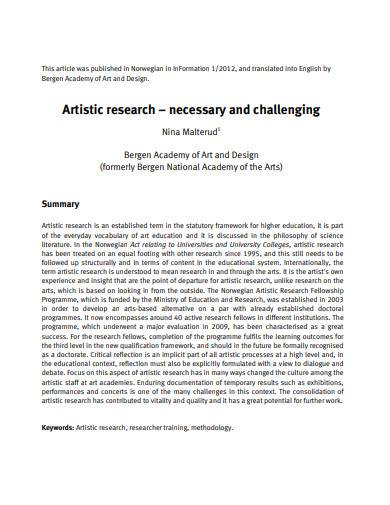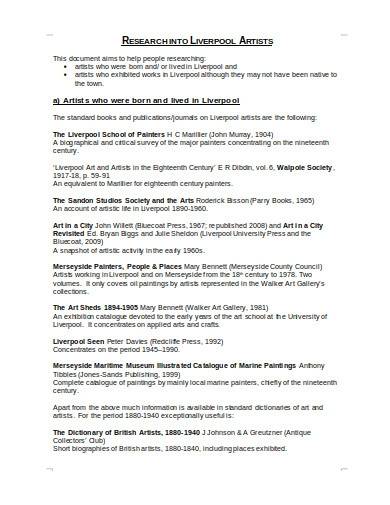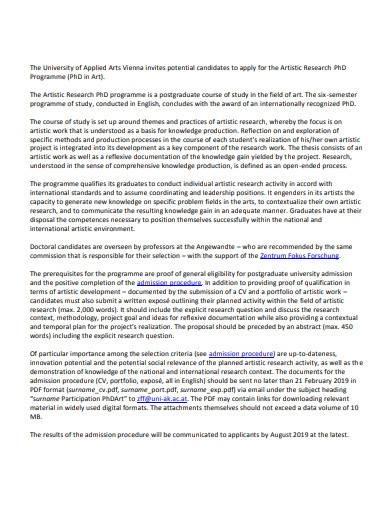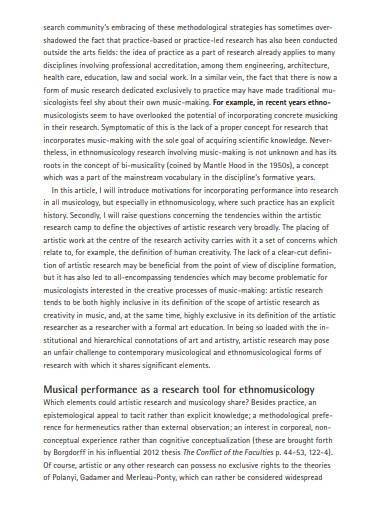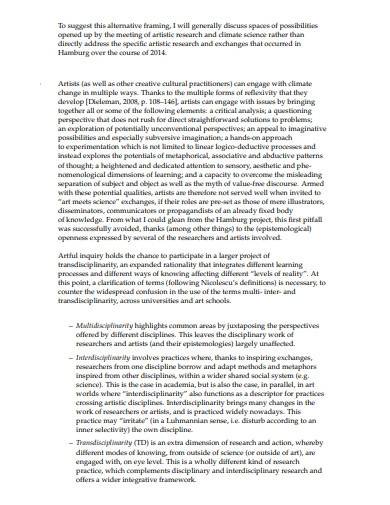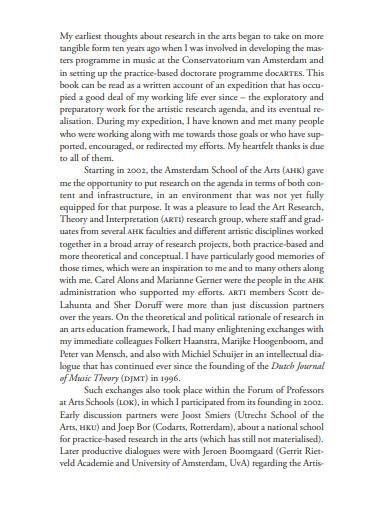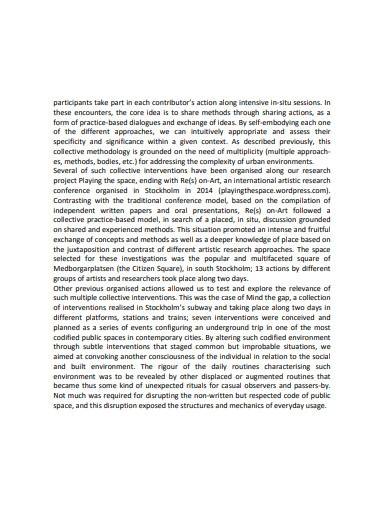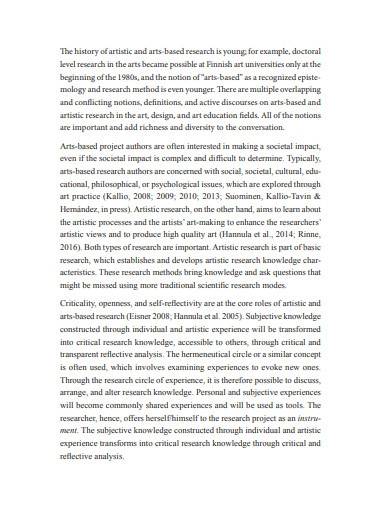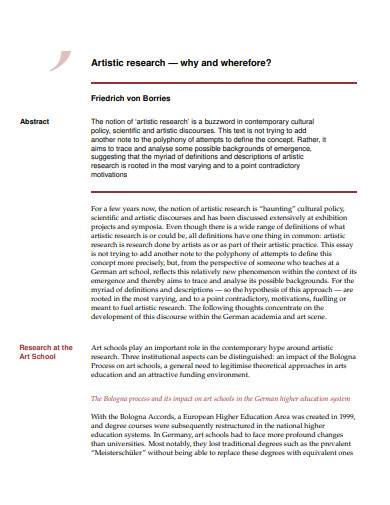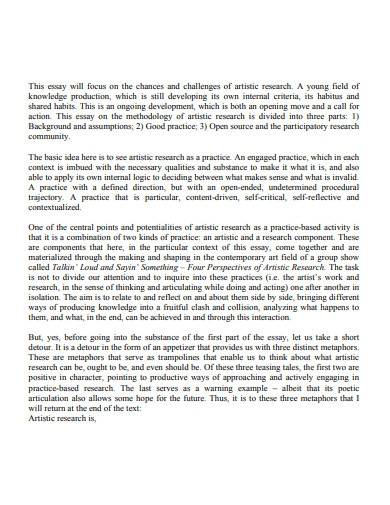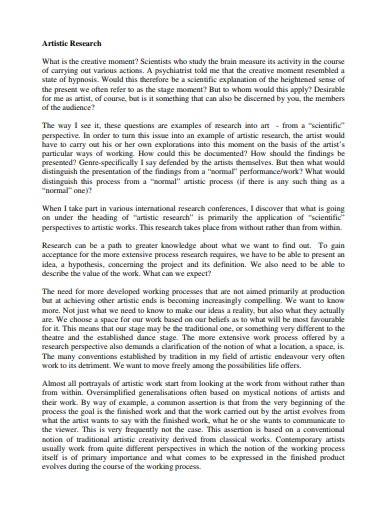Artistic research can take many forms, including performance, installation, video, sound, and multimedia works. It often involves collaboration between artists, scholars, and scientists from different disciplines, and can include experimental approaches to traditional research methodologies.
FREE 10+ Artistic Research Samples & Templates
1. Artistic Research Template
2. Artists Research Template
3. Artist PhD Research Template
4. Sample Artistic Research in Music
5. Professional Artistic Research
6. Formal Artistic Research Template
7. Artistic Research Method Sample
8. Artistic History Research Template
9. Artistic Practice Research Template
10. Art & Artistic Research Template
11. Sample Artistic Research Template
What is Artistic Research?
Artistic research is a practice that has gained increasing attention and recognition in recent years. It combines artistic production with research methods and techniques, creating a unique approach to knowledge creation and dissemination. This essay will explore the concept of artistic research, its goals, methods, and benefits. One of the key benefits of artistic research is its ability to bridge the gap between academic research and artistic practice. It encourages artists to take a more critical and reflective approach to their work, creating a space for experimentation and exploration.
How To make Artistic Research?
The primary goal of artistic research is to generate new insights and knowledge through artistic means. This practice involves using creative methods to explore research questions or topics, resulting in the creation of new artistic works or pieces. Making artistic research involves a combination of creativity, critical thinking, and research methodologies. Here are some steps that can help you make artistic research:
Step 1- Choose a Topic
Start by selecting a topic that you are interested in and that relates to your artistic practice. Consider the research questions you want to explore and the type of artistic medium you want to use.
Step 2- Research
Conduct a literature review to gather information on the topic. This can include academic articles, books, and other relevant sources. Take notes and highlight key ideas that can inform your artistic work.
Step 3- Experiment
Use artistic methods to explore your research questions. This can include improvisation, experimentation, and collaboration with other artists and researchers. This process should involve both critical thinking and creative expression.
Step 4- Reflect
Reflect on your artistic work and research findings. Analyze the results and consider the implications for your artistic practice and the broader academic and artistic communities. Share your findings and artistic work with others through exhibitions, publications, and performances. This can help to promote social and cultural change and contribute to the broader academic and artistic communities.
What are some examples of artistic research?
Examples of artistic research include Trevor Paglen’s work on surveillance and technology, Mona Hatoum’s exploration of displacement and political conflict, and Olafur Eliasson’s investigations into climate change and sustainability.
How is artistic research different from traditional academic research?
Artistic research uses creative methods and techniques to explore research questions or topics, while traditional academic research relies on more conventional research methods such as surveys, experiments, and case studies. Artistic research is often interdisciplinary and combines artistic production with research methodologies.
What are the challenges of artistic research?
Artistic research can be challenging due to its interdisciplinary nature and the need to balance creative expression with critical thinking. It can also be difficult to communicate research findings through artistic means, particularly to academic audiences who may not be familiar with artistic practices. Funding for artistic research can also be limited, making it difficult for artists to devote the necessary time and resources to their work.
In conclusion, artistic research is a unique and innovative approach to knowledge creation and dissemination. It combines artistic production with research methods and techniques, creating a space for experimentation, exploration, and collaboration. Artistic research has the potential to bridge the gap between academic research and artistic practice, promoting social and cultural change. By using creative methods to explore research questions or topics, artistic research can create new insights and knowledge that contribute to the broader academic and artistic communities.
Related Posts
FREE 10+ Content Validity Samples & Templates in PDF
FREE 10+ Construct Validity Samples & Templates in MS Word | PDF
FREE 10+ Code of Human Research Ethics Samples & Templates in MS Word | PDF
FREE 10+ Biography Research Report Samples and Templates in PDF
FREE 10+ System Documentation Samples & Templates in MS Word | PDF
FREE 10+ Process Document Samples & Templates in MS Word | PDF
FREE 10+ Action Research Samples & Templates in PDF
FREE 10+ Longitudinal Research Samples & Templates in PDF | MS Word
FREE 10+ Causal Research Samples & Templates in MS Word | PDF
FREE 10+ Client Discovery Samples & Templates in MS Word | PDF
FREE 10+ Null Hypothesis Samples & Templates in MS Word | PDF
FREE 9+ Product Knowledge Samples & Templates in PDF
FREE 10+ Software Documentation Samples & Templates in MS Word | PDF
FREE 10+ Exploratory Research Samples & Templates in PDF | MS Word
FREE 10+ Experimental Research Samples & Templates in MS Word | PDF

